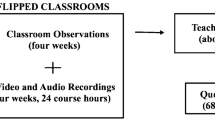Abstract
Khan Academy (KA) is a free web-based intelligent tutor, which has been featured in countless media outlets for its potential to change mathematics instruction. The founder and executive director, Salman Khan, recommends that KA be used to personalize instruction, freeing up class time for engaging high yield activities like student discourse and meaningful collaborative projects (Gupta, 2012; Khan, 2012; Markus, 2011). Teachers have begun to use KA to flip classroom instruction. This study examined how KA was used as a tool for instruction in middle and high school mathematics classrooms. The five participants reported that the uses of KA conflicted with Khan’s vision of how his program should be used and with widely accepted effective teaching strategies (2012). Nevertheless, the participants believed that Khan Academy has the potential to improve mathematics instruction due to its accessibility and its individualized learning environment.
Similar content being viewed by others
References
Abramovich, S., Schunn, C., & Higashi, R. (2013). Are badges useful in education?: It depends upon the type of badge and expertise of learner. Educational Technology Research and Development, 61(2), 217–232.
Anderson, J. R., Corbett, A. T., Koedinger, K. R., & Pelletier, R. (1995). Cognitive tutors: Lessons learned. The Journal of the Learning Sciences, 4(2), 167–207.
Ash, K. (2013). Idaho pilots effort to integrate khan academy videos. Education Week, 32(24),9.
Azevedo, R. (2002). Beyond intelligent tutoring systems: Using computers as METAcognitive tools to enhance learning? Instructional Science, 30(1), 31–45.
Beal, C. R., Arroyo, I. M., Cohen, P. R., & Woolf, B. P. (2010). Evaluation of Animal Watch: An intelligent tutoring system for arithmetic and fractions. Journal of Interactive Online Learning, 9(1).
Bergmann, J., & Sams, A. (2012). Flip your classroom: Reach every student in every class every day. Eugene, OR: International Society for Technology in Education.
Bloom, B. S. (1984). The 2 sigma problem: The search for methods of group instruction as effective as one-to-one tutoring. Educational Researcher, 13(6), 4–16.
Common Core State Standards Initiative. (2010). Common core state standards for mathematics. Washington, DC: National Governors Association Center for Best Practices and the Council of Chief State School Officers.
Corbin, J. M., & Strauss, A. (1990). Grounded theory research: Procedures, canons, and evaluative criteria. Qualitative Sociology, 13(1), 3–21.
Gates, B. (2012, April 18). The world’s 100 most influential people. Time Magazine, Retrieved from http://www.time.com/time/specials/packages/article/0,28804,2111975_2111976_2111942,00.html
Gupta, S. (Correspondent), & Fager, J. (Director). (2012, March 11). Khan Academy: The future of education? In B. Owens (Executive Producer), 60 Minutes. New York, NY: CBSNews. Available from http://www.cbsnews.com/video/watch/?id=7401696n
Khan Academy. (2014). School Pilots. Khanacademy.org Retrieved from https://www.khanacademy.org/talks-and-inter-views/school-pilots/v/oakland-unity
Khan, S. (2012). The one world schoolhouse: Education reimagined. Hachette Digital, Inc.
Koedinger, K. R., McLaughlin, E. A., & Heffernan, N. T. (2010). A quasi-experimental evaluation of an on-line formative assessment and tutoring system. Journal of Educational Computing Research, 43(4), 489–510. doi:10.2190/EC.43.4.d
Kulik, C. C., Kulik, J. A., & Bangert-Drowns, R. L. (1990). Effectiveness of mastery learning programs: A meta-analysis. Review of Educational Research, 60, 265–299.
Flick, U. (1998). An introduction to qualitative research. Thousand Oaks, California: Sage.
LaFee, S. (2013). Flipped learning. The Education Digest, 79(3), 13–18. Retrieved from http://search.proquest.com/docview/1449599156?accountid=2909
Markus, D. (Executive Producer). (2011, September 30). Salman Khan on liberating the classroom for creativity (Big Thinkers Series). Edutopia.org Retrieved from http://www.edutopia.org/salman-khan-academy-flipped-classroom-video
McMillan, J. H. (1996). Educational research: Fundamentals for the consumer. New York, NY: HarperCollins College Publishers.
National Council of Teachers of Mathematics. (2000). Principles and standards for school mathematics (Vol. 1). National Council of Teachers of Mathematics.
Noer, M. (2012, November 2). One man, one computer, 10 million students: How Khan Academy is reinventing education. Forbes.com. Retrieved from http://www.forbes.com/sites/michaelnoer/2012/11/02/one-man-one-computer-10-million-students-how-khan-academy-is-reinventing-education/
Sibbet, D. (2012, December 17). Visual leaders: New tools for visioning, management, and organization change [Google eBook]. Hoboken, NJ: John Wiley & Sons.
Taylor, V. (2013, August 14). 2013 NCWIT summit - plenary II, educational disruptions by Ben Eater (KA Lead Developer). NCWIT.org. Retrieved from http://www.ncwit.org/video/2013-ncwit-summit-plenary-ii-educational-disruptions-ben-eater
TED. (2011, March). Salman Khan: Let’s use video to reinvent education [Online news-group]. Retrieved from http://www.ted.com/talks/salman_khan_let_s_use_video_to_reinvent_education.html
United States Census Bureau. (2014, February 3). Measuring America: Computer and internet trends in America. Retrieved from https://www.census.gov/hhes/computer/files/2012/Computer_Use_Infographic_FINAL.pdf.
Vigdor, J. (2013). Solving America’s Math Problem. Education Next, 13(1), n1.
Wambugu, P. W., & Changeiywo, J. M. (2008). Effects of mastery learning approach on secondary school students’ physics achievement. Journal of Mathematics, Science & Technology Education, 4(3), 293–302.
Watson, J., Murin, A., Vashaw, L., Gemin, B., & Rapp, C. (2013). Keeping pace with K-12 online & blended learning: An annual review of policy and practice. Evergreen Education Group. Retrieved from http://kpk12.com/reports/.
Yildiran, G., & Aydin, E. (2005). The effects of mastery learning and cooperative, competitive and individualistic learning environment organizations on achievement and attitudes in mathematics. Journal of the Korea Society of Mathematical Education Series D: Research in Mathematical Education, 9(1), 55–72.
Author information
Authors and Affiliations
Corresponding author
Rights and permissions
About this article
Cite this article
Cargile, L.A., Harkness, S.S. Flip or Flop: Are Math Teachers Using Khan Academy as Envisionedby Sal Khan?. TECHTRENDS TECH TRENDS 59, 21–28 (2015). https://doi.org/10.1007/s11528-015-0900-8
Published:
Issue Date:
DOI: https://doi.org/10.1007/s11528-015-0900-8




